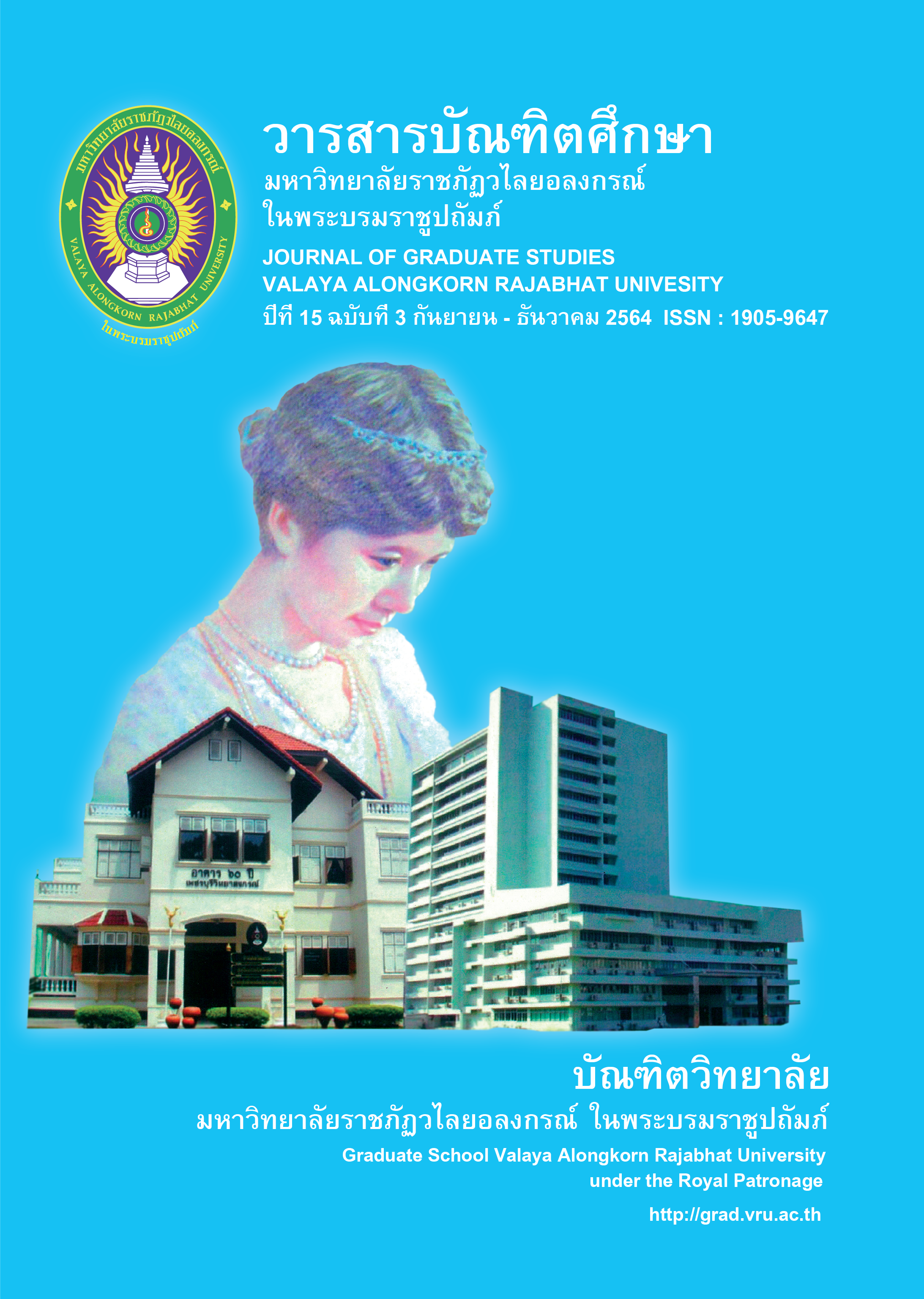รูปแบบการพัฒนาความสามารถในการสร้างสรรค์นิทานคุณธรรม สำหรับนักศึกษาคณะครุศาสตร์ มหาวิทยาลัยราชภัฏเชียงใหม่
Main Article Content
บทคัดย่อ
การวิจัยครั้งนี้มีวัตถุประสงค์เพื่อ 1) สร้างรูปแบบการพัฒนาความสามารถในการสร้างสรรค์นิทานคุณธรรมสำหรับนักศึกษาคณะครุศาสตร์ มหาวิทยาลัยราชภัฏเชียงใหม่ 2) ศึกษาผลการใช้รูปแบบการพัฒนาความสามารถในการสร้างสรรค์นิทานคุณธรรมสำหรับนักศึกษา
คณะครุศาสตร์ มหาวิทยาลัยราชภัฏเชียงใหม่ และ 3) ศึกษาความพึงพอใจของนักศึกษาที่มีต่อขั้นตอนการพัฒนา กลุ่มตัวอย่าง คือ นักศึกษาคณะครุศาสตร์ จำนวน 54 คน ที่ลงทะเบียนเรียนในรายวิชาการวิจัยทางการศึกษา ในภาคเรียนที่ 1 ปีการศึกษา 2562 ดำเนินการวิจัยวันที่ 1 กรกฎาคม 2562 ถึงวันที่ 30 กันยายน 2562 เครื่องมือที่ใช้ในการวิจัย คือ แบบประเมินคุณภาพของรูปแบบมีลักษณะเป็นแบบมาตรประมาณค่า 5 ระดับ ตรวจสอบความตรงเชิงเนื้อหาได้ค่าดัชนีความสอดคล้องเท่ากับ 1.00 ทุกข้อ แบบประเมินคุณภาพนิทานคุณธรรม ลักษณะเป็นแบบมาตรประมาณค่า 5 ระดับ ตรวจสอบความตรงเชิงเนื้อหาได้ค่าดัชนีความสอดคล้องมีค่าอยู่ระหว่าง 0.67-1.00 และแบบสอบถามความพึงพอใจที่มีต่อขั้นตอนการพัฒนาเป็นแบบมาตรประมาณค่า 5 ระดับและคำถามปลายเปิด ตรวจสอบความตรงเชิงเนื้อหาได้ค่าดัชนีความสอดคล้องมีค่าอยู่ระหว่าง 0.67-1.00 และความเชื่อมั่นเท่ากับ 0.80 วิเคราะห์ข้อมูลด้วยการหาค่าเฉลี่ย ส่วนเบี่ยงเบนมาตรฐาน และการวิเคราะห์เนื้อหา
ผลการวิจัยพบว่า 1) รูปแบบการพัฒนาความสามารถในการสร้างสรรค์นิทานคุณธรรมของนักศึกษาคณะครุศาสตร์ มหาวิทยาลัยราชภัฏเชียงใหม่ ได้ประยุกต์แนวคิดการพัฒนาทักษะปฏิบัติของซิมพ์ซัน (Simpson) และแฮร์โรว์ (Harrow) ประกอบด้วย องค์ประกอบที่ 1 หลักการพัฒนา องค์ประกอบที่ 2 ขั้นตอนการพัฒนามี 5 ขั้นตอน คือ การรับรู้ ศึกษาต้นแบบ ลงมือปฏิบัติ ทดลองใช้ และรายงานผล และ องค์ประกอบที่ 3 การตรวจสอบผลการพัฒนา ผลการตรวจสอบคุณภาพของรูปแบบพบว่า มีคุณภาพอยู่ในระดับดีมาก 2) ผลการใช้รูปแบบการพัฒนา พบว่า นักศึกษาสามารถสร้างนิทานคุณธรรมจำนวน 9 เรื่อง ที่เกี่ยวข้องกับหลักปรัชญาของเศรษฐกิจพอเพียงด้านความพอประมาณ ความกตัญญู ความซื่อสัตย์ ความมีวินัยและความเอื้อเฟื้อเผื่อแผ่ โดยทุกเรื่องมีคุณภาพอยู่ในระดับดีขึ้นไป 3) นักศึกษามีความพึงพอใจต่อขั้นตอนการพัฒนาในระดับมากที่สุดและมีความรู้สึกในเชิงบวกต่อขั้นตอนการพัฒนา ได้แก่ มีความภาคภูมิใจในผลงานของตนเอง การสร้างนิทานเป็นเรื่องง่าย ตลอดจนสามารถนำไปประยุกต์ใช้ในการเป็นครู่ได้ในอนาคต
Article Details
บทความทุกเรื่องได้รับการตรวจความถูกต้องทางวิชาการโดยผู้ทรงคุณวุฒิ ทรรศนะและข้อคิดเห็นในบทความวารสารบัณฑิตศึกษา มหาวิทยาลัยราชภัฏวไลยอลงกรณ์ ในพระบรมราชูปถัมภ์ มิใช่เป็นทรรศนะและความคิดของผู้จัดทำจึงมิใช่ความรับผิดชอบของบัณฑิตวิทยาลัย มหาวิทยาลัยราชภัฏวไลยอลงกรณ์ ในพระบรมราชูปถัมภ์ กองบรรณาธิการไม่สงวนสิทธิ์การคัดลอก แต่ให้อ้างอิงแหล่งที่มา
เอกสารอ้างอิง
Aunpia, S. & Wattanasukchai, K. (2014). phonkān čhat kitčhakam sinlapa tām nǣokhit khō̜ng hǣrōthī mī tō̜ khwāmsāmāt nai kān pan khō̜ng dek ʻāyu kao - sipʻet pī [Effects of art activities management towards Harrow’s theory on abilities of clay modeling of children aged 9-11 years old]. An Online Journal of Education, 9(1), 458-472. Retrieved from https://so01.tci-thaijo.org/index.php/OJED/article/view/34808
Buosonte, R. (2009). kānwičhai læ phatthanā nawattakam kānsưksā [Research and development of educational innovation]. Bangkok: Kham Samai.
Chindanuruk, T. (2017). khrū læ nakrīan nai yuk kānsưksā Thai 4.0 [Teachers and Students in Thailand Education 4.0]. Electronic Journal of Open and Distance Innovative Learning (e-JODIL). 7(2), 14-29. Retrieved from https://ejodil.stou.ac.th/filejodil/16_0.pdf
Chonburi, I., Phanichphalinchai, T., & Wiboonrangsan, S. (2010). kānphatthanā chut kitčhakam nithān songsœ̄m khunnatham čhariyatham samrap nakrīan chan prathomsưksā pī thī sī [The development of a story activities package enhancing morality and ethics of Phathomsuksa IV students]. Journal of Education NARESUAN University. 12(3), 97-112. Retrieved from https://so06.tci-thaijo.org/index.php/edujournal_nu/article/view/9300
Faculty of Education. (2019). phǣn patibatkān pračham pīngoppramān Phō̜.Sō̜. 2562 [Action Plan for the budget year 2019]. Faculty of Education, Chiang Mai Rajabhat University.
Harrow, A. (1972). A Taxonomy of the psychomotor domain: A guide for developing behavioral objective. New York: Longman.
Ministry of Education. (2017). phǣn phatthanākān sưksā hǣng chāt chabap thī sipsō̜ng (Phō̜.Sō̜. 2560 - 2564) [The 12th National Education Development Plan (2017-2021)]. Retrieved from https://waa.inter.nstda.or.th/stks/pub/2017/20170313-Education-Development-Plan-12.pdf.
Panphu, K. (2018). khwāmsamphan rawāng kān tranak rūkhun khā nai tonʻēng thī mī ō̜ paomāi læ khwāmsamret nai kān rīan tām lak ʻitthi bāt sī kō̜ranī sưksā : isit radap parinyā trī khana manutsayasāt mahāwitthayālai mahā čhulā long kō̜n a rāt witthayālai [Relationship between self-esteem towards study’s goals and accomplishment according to the 4 iddhipada case study : B.A. student of Mahaculalongkronrajvidyalaya university’s Humanities faculty]. Journal of MCU Humanities Review. 4(1), 37-46. Retrieved from https://so03.tci-thaijo.org/index.php/human/issue/view/11136
Puachindanet, C. (2015). rūpbǣp kānsō̜n thaksa patibat dūai kitčhakam mō̜n fǣn sī samrap nakrīan chan prathomsưksā tō̜n plāi [The performance skill teaching model with fancy pillow activity for the senior students’ level]. Bangkok: Faculty of Education, Chulalongkorn University.
Sanjaiprom, S. (2019). rūpbǣp kānphatthanā khwāmsāmāt dān kānsāng san nithān khunnatham samrap naksưksā Khana Kharusāt mahāwitthayālai rātchaphat Chīang Mai [The development model of creative moral tale ability for the student in the faculty of Education, Chiang Mai Rajabhat University]. Chiang Mai: Faculty of Education, Chiang Mai Rajabhat University.
Secretariat Office of the Teachers Council. (2019). khō̜bangkhap khuru saphāwā dūai māttrathān wichāchīp khrū (chabap thī sī) Phō̜.Sō̜. 2562 [Regulations of the Teachers Council of Thailand on Teacher Profession Standards (Issue 4) B.E. 2562]. Government Gazette. 123(special episode 68 D), 18-20. Retrieved from http://www.ksp.or.th/ksp2018/wp-content/uploads/2018/11/T_0018.pdf
Simpson, D. (1972). Teaching physical education: A system approach. Boston: Houghton Mufflin Co.
Soraphum, T. & Thanapatmeemanee, H. (2019). kānčhatkān rīan kānsō̜n bǣp phasomphasān prakō̜p nǣokhit khō̜ng phư̄a sœ̄msāng thaksa patibat læ phon samrit thāngkān rīan rư̄ang kān wat manti mitœ̄ samrap naksưksā radap prakāsanīyabat wichāchīp chan pī thī nưng [Blended Learning Management by Integrating Simpson’s Model to Encourage the Practical Skills and Learning Achievement in Multimeters Measurement for First Year Vocational Certificate Students]. Journal of Education, Mahasarakham University. 13(2), 149-160. Retrieved from https://edu.msu.ac.th/journal/home/journal_file/593.pdf
Thamrongthanyawong, S. (2014). patčhai thī mī phon tō̜ khunnaphāp kānsưksa [Factors affecting the quality of education]. Retrieved from https://www.facebook.com/Prof.SombatThamrongthanyawong/posts/779095742131419/


